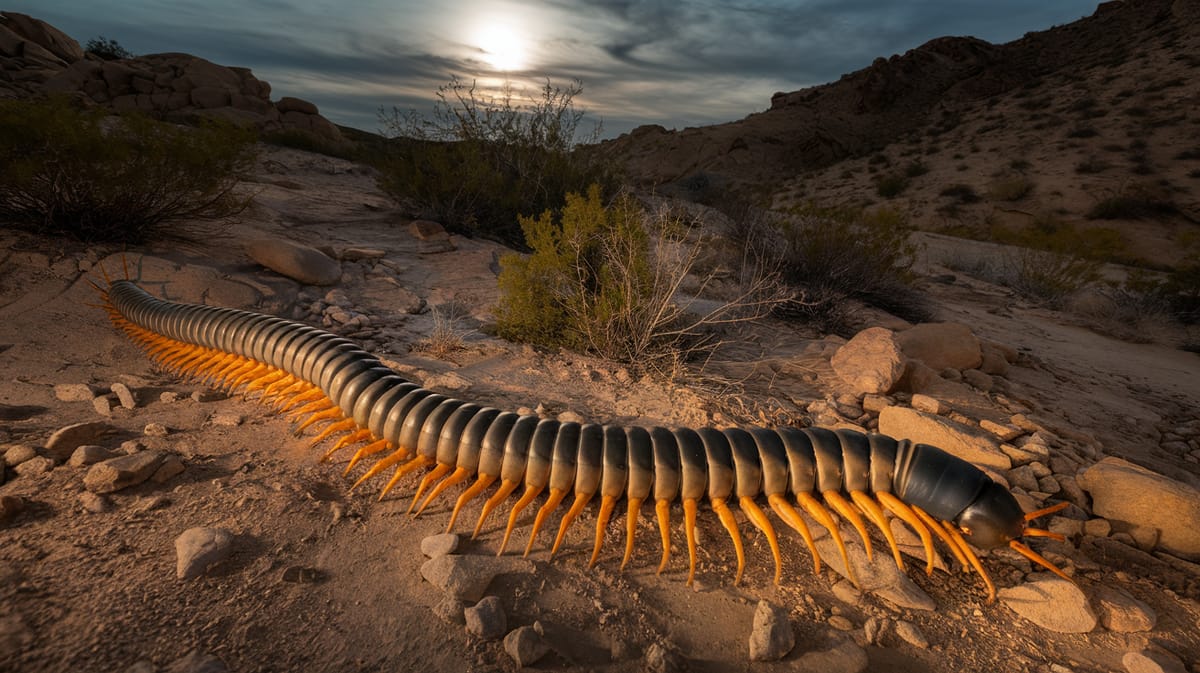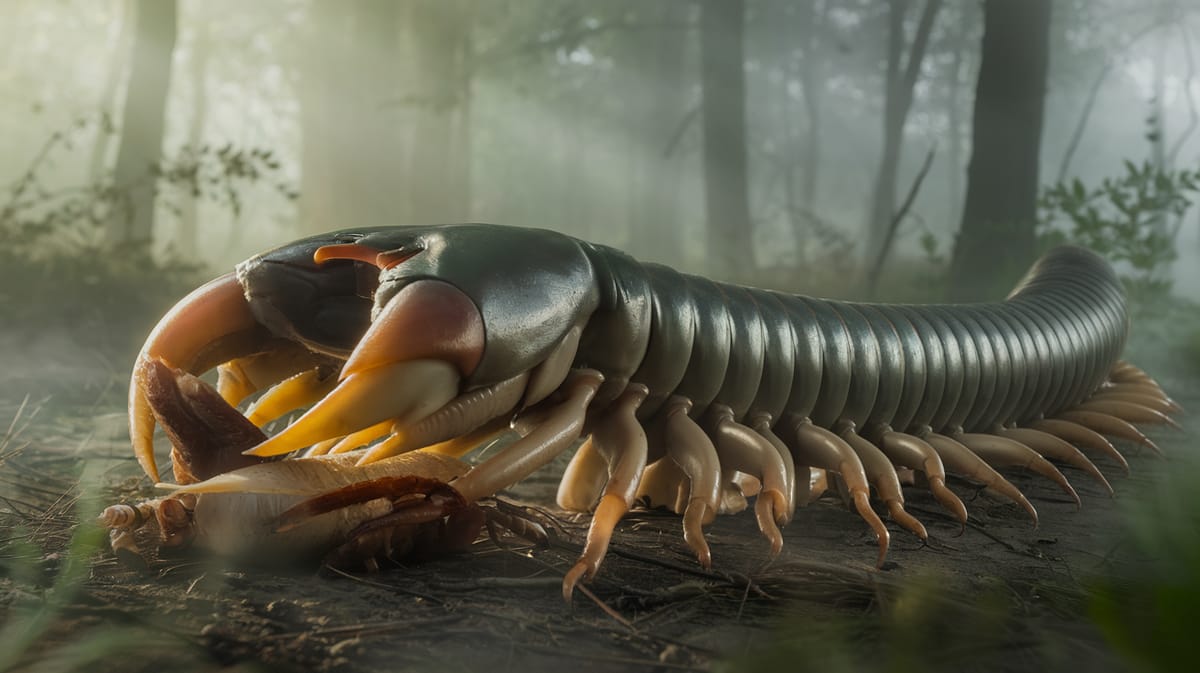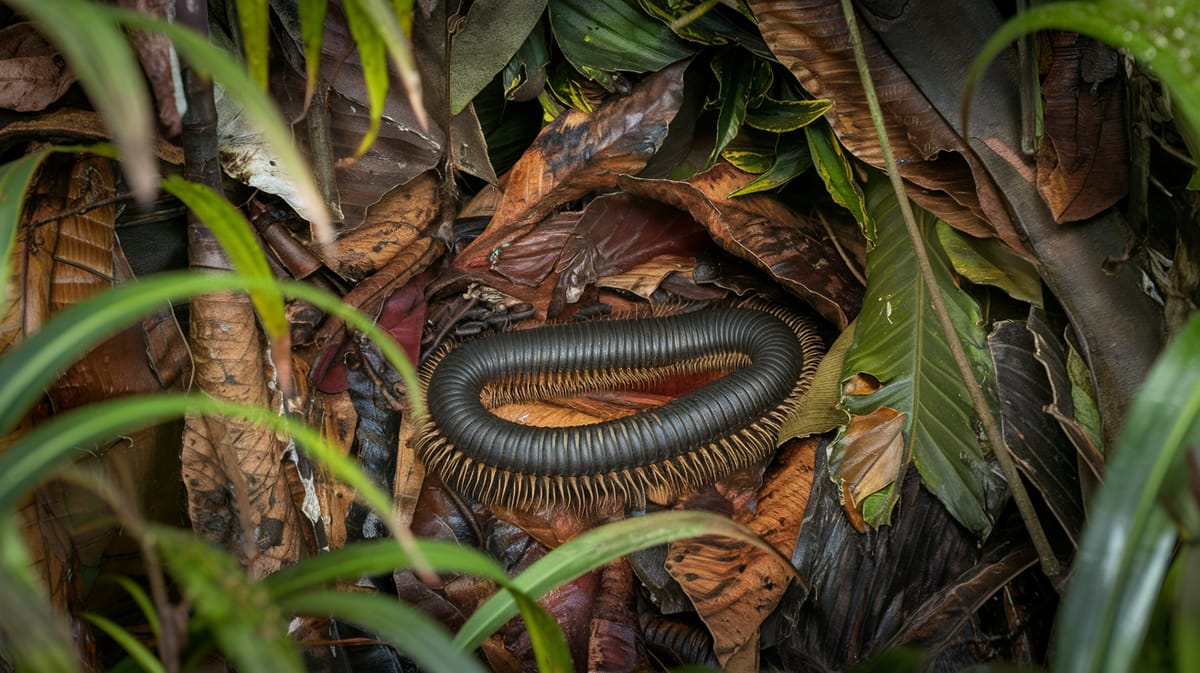Giant Centipede
Fierce and formidable, the Giant Centipede is a fast-moving predator, known for its venomous bite and agile hunting skills. Thriving in warm climates, it plays a key role in controlling insect populations.

Key Insights at a Glance
Did You Know?
Taxonomy & Classification
Giant centipedes exhibit remarkable predatory adaptations with venomous fangs and agile movement, reflecting their evolutionary success as formidable arthropod hunters. Let's understand the evolutionary journey and classification of these remarkable predators.
Global Distribution
Scolopendra species thrive in tropical and subtropical regions, with over 100 species showcasing adaptability to diverse environments worldwide.
Evolutionary Resilience
Originating over 400 million years ago, giant centipedes have survived major extinction events, evolving efficient predatory traits over millennia.
Lifecycle and Growth
A remarkable journey of transformation from Egg to Adult.
Egg
Laid in hidden, humid environments, giant centipede eggs develop embryos protected by their mother's body until hatching.
Juvenile
Juveniles molt multiple times, gradually increasing in size and adding more leg pairs with each molt.
Adult
Adults exhibit aggressive hunting behavior, using venomous fangs to subdue prey, and engage in mating rituals.
Dietary Habits
An agile predator with impressive hunting skills, it consumes insects, small vertebrates, and opportunistic prey with ease.
| DIET TYPE | DESCRIPTION |
|---|---|
| Primary Diet | Primarily feeds on spiders, crickets, and cockroaches, using venomous claws to capture and subdue. |
| Secondary Diet | Occasionally eats small mammals and amphibians, such as frogs and mice, when they are accessible. |
| Occasional | Rarely targets small birds and snakes, taking advantage of infrequent opportunities in its environment. |

Behaviour and Adaptations
Discover the incredible adaptations that make the Giant Centipede a formidable predator in its environment.
Venomous Bite
Potent venom immobilizes prey rapidly, ensuring successful capture.
Nocturnal Hunting
Efficiently hunts under the cover of darkness, exploiting its keen sense of touch and vibration.
Segmented Agility
Flexible body segments allow swift movement through complex terrains.
Ecosystem Impact
Giant Centipedes play a crucial role in maintaining ecological balance through predation and nutrient recycling.
Natural Pest Control
Controls populations of insects and small animals, preventing overpopulation.
Food Chain Connection
Serves as both predator and prey, linking different trophic levels.
Nutrient Recycler
Aids in decomposition by consuming dead organisms, enriching soil health.
Conservation Challenges
Addressing key threats faced by Giant Centipede populations.
Habitat Destruction
Deforestation and urbanization reduce natural habitats for centipedes.
Climate Change
Altered temperatures and precipitation patterns disrupt centipede ecosystems.
Invasive Species
Competing species and predators threaten native centipede populations.
Frequently Asked Questions
How long do Giant Centipede live?
Giant Centipedes typically live for about 5 to 7 years in the wild. Their lifespan can vary depending on environmental conditions and availability of food. In captivity, with proper care, they may live slightly longer, reaching up to 10 years.
What do Giant Centipede eat?
Giant Centipedes are carnivorous and feed on insects, spiders, small mammals, reptiles, and even birds. They use their venomous claws to capture and paralyze prey, making them effective hunters in their natural habitat.
Are Giant Centipede poisonous?
Yes, Giant Centipedes are venomous. They possess venomous claws called forcipules, which they use to inject venom into their prey. While their venom can cause pain and swelling in humans, it is not considered life-threatening.
Are Giant Centipede endangered?
Giant Centipedes are not currently classified as endangered. They have a broad distribution in tropical and subtropical regions, and their population is stable. However, habitat destruction and environmental changes can impact local populations.
What do Giant Centipede symbolize?
In various cultures, Giant Centipedes symbolize power, fear, and protection. In some Asian cultures, they are seen as protectors against other pests and are sometimes used in traditional medicine. Symbolism can vary widely depending on cultural context.
Do Giant Centipede bite?
Yes, Giant Centipedes can bite if they feel threatened. Their bites can be painful and may cause localized swelling, redness, and discomfort. While generally not dangerous to humans, medical attention may be needed if an allergic reaction occurs.
What color are Giant Centipede?
Giant Centipedes typically have a reddish-brown or dark brown body with yellow or orange legs. Their coloration can vary depending on the species and geographic location. This coloration helps them blend into their natural environment for hunting and protection.
Does a Giant Centipede have wings?
No, Giant Centipedes do not have wings. They are terrestrial arthropods with numerous legs, which they use for swift movement across the ground. Their elongated bodies and many legs help them navigate through their environment efficiently.
What does a Giant Centipede look like?
Giant Centipedes have long, segmented bodies with numerous pairs of legs, typically 15 to 23 pairs. They have a flattened appearance, with a pair of venomous claws near the head. Their coloration is often reddish-brown with yellow or orange legs.
Is a Giant Centipede an insect?
No, a Giant Centipede is not an insect. It belongs to the class Chilopoda, distinct from insects, which are in the class Insecta. Centipedes are arthropods with multiple legs per body segment, unlike insects, which typically have three pairs of legs and three body segments.
Related Insects
Discover insects with similar characteristics to Giant Centipede - including shared habitats, diets, and taxonomic classifications
Share this profile
Help others discover Giant Centipede
